Galleries
David Ebony’s Top 10 New York Gallery Shows for July
Lindsay Morris has a timely study of a camp for transgender kids.

Lindsay Morris has a timely study of a camp for transgender kids.

David Ebony

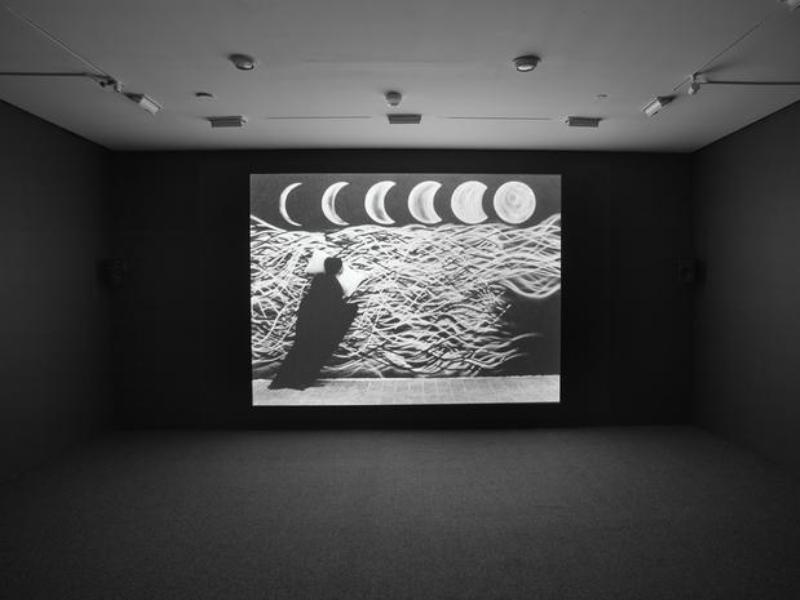
Robin Rhode, The Moon is Asleep (2015).
Photo: Courtesy the artist and Lehmann Maupin Gallery.
1. Robin Rhode at Lehmann Maupin, through August 21.
South African-born, Berlin-based artist Robin Rhode is a strong presence in New York at the moment. He has a major gallery show, plus an exhibition at the Drawing Center concurrently on view.
In his terrific show of recent works at Lehmann Maupin, titled “Borne Frieze,” Rhode (who has been commissioned for the upcoming Performa Biennial) offers a number of challenges to the viewer. For instance, it is difficult to see exactly what is going on in Light Giver Light Taker (2015), a room-size installation. Peering into the darkened room, illuminated only sporadically by flashing strobes, one can discern two oversize lightbulbs made of polyurethane foam, one black and the other white. They seem to have been dragged around the room, their trails indicated by faint chalk marks in black and white against the gray floor.
A metaphorical clash immediately arises in the racial terms of black light and white light, suggested by the objects. Is this how Rhode sees the world, or how the world is illuminated—polarized by either black light or white light? Where is this all leading?
Rhode titled the exhibition after “Born Frees,” the term used to refer to the generation of South Africans born after Apartheid. And, according to the show’s press release, Rhode explores in the recent work the contrast between old ideals and new desires.
Absent riders haunt Chalk Bike, an installation in which the movements of real bikes have left white chalk marks against the black walls lining a large gallery. These were created by the artist in a solo performance in advance of the show’s opening, with perhaps only a few gallery attendants looking on.
The exhibition’s highlight for me is The Moon is Asleep, a quirky and riveting new film showing continuously in a rear gallery. Technically very simple, in black and white, and refreshingly free of CGI theatrics (the bane of too many art films these days), The Moon is Asleep is lyrically complex, and has the feel of a fairytale. A figure in a long robe or dressing gown pretends to sleep in bed with a pillow; but he is actually, and obviously, standing up. As the night passes in quick motion, he moves across the set (a black wall) while rudimentary drawings of the phases of the moon, and shimmering ocean waves unfold and undulate in the background.
The novel combination of film and drawing relates to many other Rhode works, including a photo series featuring images of a surfer, highlighted in “Drawing Waves,” the artist’s Drawing Center exhibition, which is on view through August 30.
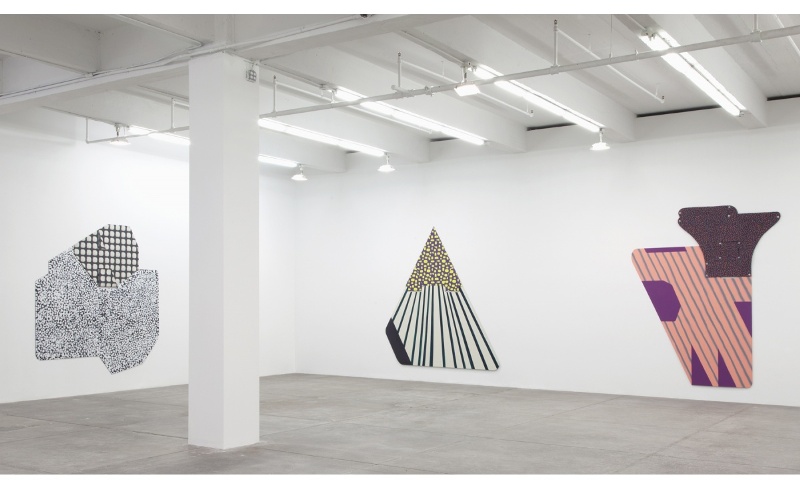
Installation view, Ruth Root, 2015.
Photo: Courtesy Andrew Kreps Gallery.
2. Ruth Root at Andrew Kreps, through August 14.
The seven large, recent abstract painted fabric constructions by Chicago-born, New York-based artist Ruth Root in this show are filled with humor. And they are among the best works of her career.
Averaging some six by nine feet, the works, all untitled, appear as shaped, painted canvases, but are, in fact, elaborate constructions featuring cut pieces of Plexiglas, and sewn panels of stained and painted fabric.
In its crazy-quilt way, Root’s work balances whimsy and profundity that, at times, recalls early pieces by Richard Tuttle. However, with their human scale, Root’s efforts offer a more immersive experience.
While abstract, the new pieces have a certain relationship to the wacky inventiveness of the Chicago Imagist school of figurative painters, including Jim Nutt and Ed Paschke. One striking work by Root, over eight feet tall, features a kind of inverted diamond-shaped panel, with a triangular area of small hard-edge elements in yellow set against a purple ground. This panel surmounts a larger section filled with a kind of starburst motif, with green bands set against white, emanating from the top toward the lower edge of the panel. Works like this prove that rigorous painting can also be exuberant.

Lindsay Morris, Meadow (2012).
Photo: Courtesy of ClampArt.
3. Lindsay Morris at ClampArt, through August 21.
With all the media attention lavished on Caitlyn Jenner, and transgender issues of late, this exhibition of Lindsay Morris’s photo study of a camp for transgender children could not be more timely—or poignant. In the series, “You are You,” Morris documents a summer camp for gender non-conforming kids in the Midwest, which she has been attending since 2007.
The color photographs in uniform, modest size (13 by 19 inches each), show happy kids, playing dress-up, frolicking through the countryside in high-heels, or putting on makeup. The Detroit-born, New York-based Morris has chosen to emphasize the joyfulness of these children at camp, and only hint at the trauma that their regular daily existence in the “real world” must entail.
Runway shows children putting on a fashion show with sumptuous outfits sported by youngsters of ambiguous gender. I Am and Strapless show a kid wearing dresses. Only the figure’s short-cropped hair and boyish features suggest that after blissful days at the camp, he will probably be obliged to return to his role as a boy, at least until next summer.
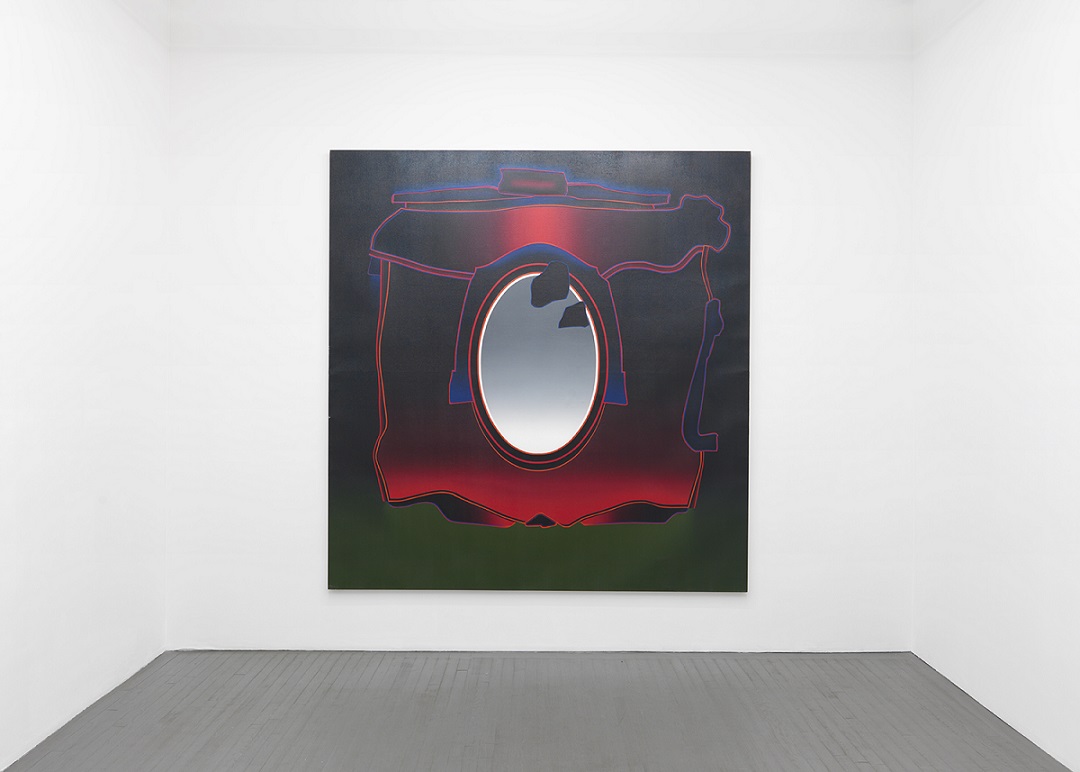
Deborah Remington, Dorset (1972).
Photo: Courtesy of Wallspace.
4. Deborah Remington at Wallspace, through August 7.
While waiting for a long-overdue, full-scale museum retrospective for the brilliant, though under-known, American painter Deborah Remington (1930-2010), Wallspace has stepped in with this thoughtful and tightly curated show of some of the artist’s best works produced between 1963 and 1983. Curated by Jay Gorney, the exhibition features a group of large resplendent paintings on canvas plus a sizable selection of works on paper.
During the 20-year period highlighted in the show, Remington refined a unique abstract space in centralized compositions filled with carefully modulated geometric forms. She used a spare and delicately nuanced palette of deep green, red, and gold, to activate hard-edge shapes set against dark grounds. Remington’s forms are related to Machine Age painting and Futurism, but she brings to the iconography a sensuous, human touch.
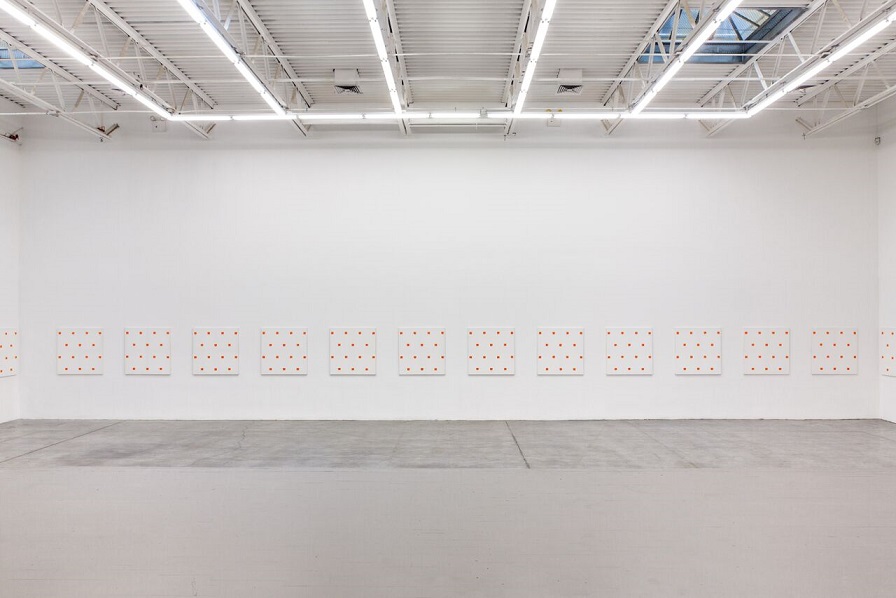
Installation view, Niele Toroni, 2015.
Photo: Courtesy of the Swiss Institute.
5. Niele Toroni at Marian Goodman, through July 30; and at the Swiss Institute, through September 6.
For over fifty years, Swiss conceptualist Niele Toroni has devoted himself to a very specific way of painting. He uses only markings of a single color in any given work and a similar brushstroke repeated in regular spatial intervals 30 centimeters apart. He applies the paint using only a No. 50 paintbrush approximately two inches wide.
Toroni’s seemingly myopic enterprise—akin to that of like-minded and similarly obsessive conceptualists Daniel Buren, André Cadere, and Roman Opalka—turns out to be remarkably versatile. Toroni’s personal, yet universal, methodology sustains him; it effectively guides him through the world, and through life.
While Toroni’s painting has been well-received internationally for decades, the current exhibition at the Swiss Institute is, surprisingly, the first-ever Toroni survey in New York. The exhibition includes a range of works from those made in the 1960s to a number of site-specific murals created by Toroni specifically for this show.
It begins with a rather imposing 1968 painting of orange markings on polymer-coated fabric, drawn from MoMA’s collection, which cascades down the wall and rolls out toward the middle of the floor. This piece corresponds to a hypnotic row of twenty-five nearly identical canvases of similar orange markings on white grounds hung on the opposite wall. Marian Goodman Gallery shows support for Toroni by presenting recent works on canvas and paper, plus a site-specific mural.
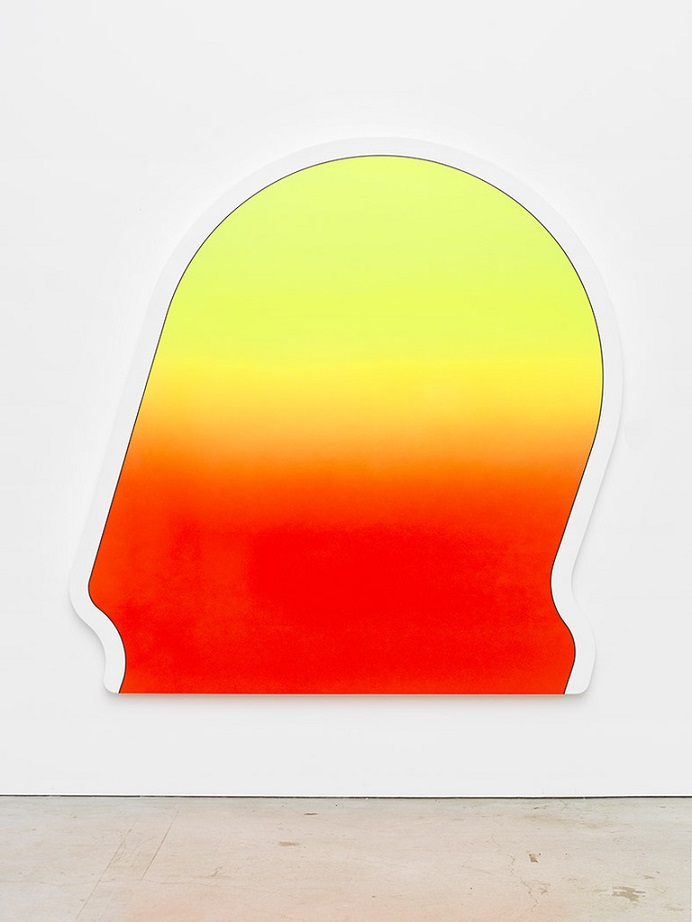
Greg Bogin,Sunny disposition (there’s always tomorrow) (2015).
Photo: Courtesy of Marlborough Chelsea.
6. Greg Bogin at Marlborough Chelsea, through August 7.
“Sunny Disposition” is an apt title for this upbeat show of new works by painter Greg Bogin. The New York artist’s brightly colored, hard-edge abstractions hark back to the heady days of Op, Abstract Pop, and Minimalism in the 1960s. But Bogin’s sardonic, ultra-slick shaped canvases are definitely of-the-moment, and seem more allied with those of his peers like Alex Israel and Jeremy DePrez.
Bogin’s meticulously painted Happy Beginnings, a ten-foot-long composition in white with narrow horizontal bands in green, purple, blue, and yellow running along the lower part of the canvas, might recall a 1960s Kenneth Noland “stripes” painting. Bogin’s work, though, features an incongruous bulbous shape, a nipple-like protrusion at the lower left. Sunny disposition (there’s always tomorrow) (2015) is even punchier. The painting’s dome-like shape resembles a giant head, a helmet, or a blazing sun, depending on your disposition.
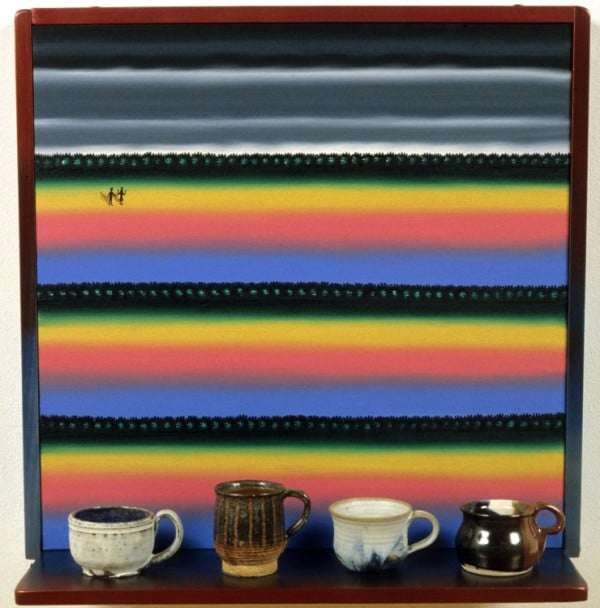
Roger Brown, Virtual Still Life #17: Cups with Handles and Desert Landscape (1994).
Photo: Courtesy of Maccarone.
7. Roger Brown at DC Moore, through July 31, and at Maccarone, through August 7.
In the decade or so before his death of an AIDS-related illness in 1997, Chicago artist Roger Brown produced a group of satirical and acerbic political-themed works, which are the focus of an extraordinary show at DC Moore.
“Political Paintings” includes works such as Gulf War (1991), a large canvas featuring highly stylized portraits of George H.W. Bush and Saddam Hussein surrounded by military choppers. The similarly grotesque look and posture of the leaders constitute a wry comment on the war machine. The self-explanatory Landscape with Dollar Sign, of the same year, is a scathing indictment of wartime economics.
Concurrently, Maccarone presents “Roger Brown: Virtual Still Life,” a group of the artist’s late works. Created in 1995 and ’96, these esoteric and rarely shown pieces incorporate actual objects—such as found ceramics and toy furniture. Arranged in neat rows on narrow shelves attached to the bottom of framed canvases, the objects complement the paintings, which typically feature a rather fanciful, dreamlike landscape. Melding painterly illusion and tangible reality, these works show Brown pushing the boundaries of his art right up to his last days.
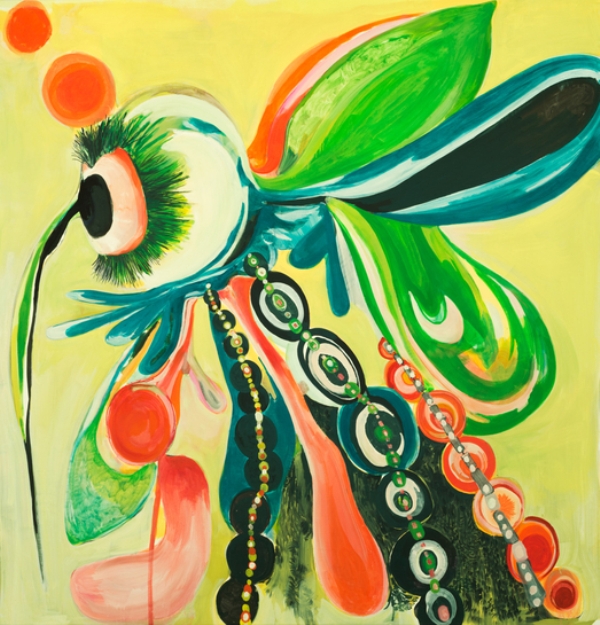
Santi Moix, Mosquit II (2015).
Photo: Courtesy of Paul Kasmin Gallery.
8. Santi Moix at Paul Kasmin, through August 14.
Each painting by Barcelona-born, New York-based painter Santi Moix seems to be the result of a gut-wrenching battle between abstraction and representation, and also between the artist and the medium of painting itself. Even if a work occasionally seems like a failure, one can sense in it a personal victory for the artist on some level.
This show of recent works, entitled “A Moment,” generates considerable excitement and contains some surprises. There is a certain fearlessness in Moix’s approach, and in his willingness to take chances to avoid settling into what might be expected of him. I also admire his strange imagery, whose hybrid plant and animal shapes remind me of certain works by the late English artist Graham Sutherland, one of my favorites.
Moix’s large painting Mosquit II (2015), for instance, one of the best of his career, features a winged insect-like animal with a huge eye, borrowed from one of Philip Guston’s late works perhaps. Moix’s insect is seen morphing into a plant. The jeweled necklace it’s wearing adds some anthropomorphic quality to this wild invention.
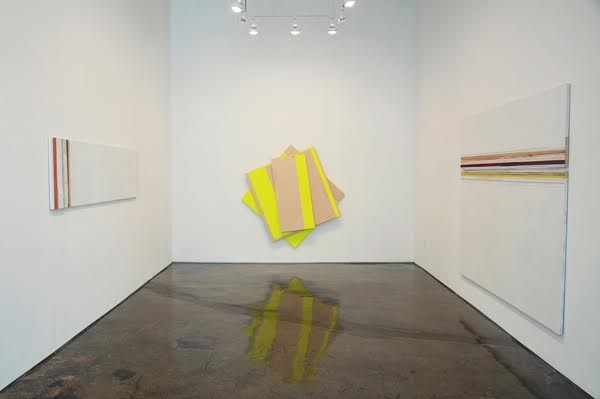
Installation view, Melissa Kretschmer / Russell Maltz, 2015.
Photo: Courtesy of Minus Space.
9. Melissa Kretschmer and Russell Maltz at Minus Space, through August 15.
“Plywood” is the title of this intimate and elegant two-person show filling Minus Space’s new ground-floor venue in DUMBO. The New York-based artists Melissa Kretschmer and Russell Maltz both use plywood frequently in their recent abstract works, but to vastly different ends.
Kretschmer’s approach is rather pictorial, using the material as a painterly surface. She carves out networks of long horizontal lines, or short vertical markings, usually gathered toward the top or center of each composition, or off to one side. One of her strongest works, Conflux (2015), features long horizontal bands of raw wood, and slats of subtly applied earth tones, set against white grounds, which suggest ghostly, panoramic landscapes.
Maltz’s art is centered on installation, in which process is key. Here, he creates variations on stacked plywood, with one area painted in his trademark DayGlo yellow. He then cuts up and hangs together the transformed plywood pieces on a single large nail, a technique that recalls Lucio Pozzi’s works of the late 1970s.
Maltz’s most striking pieces here are SR 17 Floor Stack (2015), featuring a heap of plywood planks partially over-painted with a DayGlo yellow rectangle; and a window installation of tall, leaning plywood planks visible only from the street.
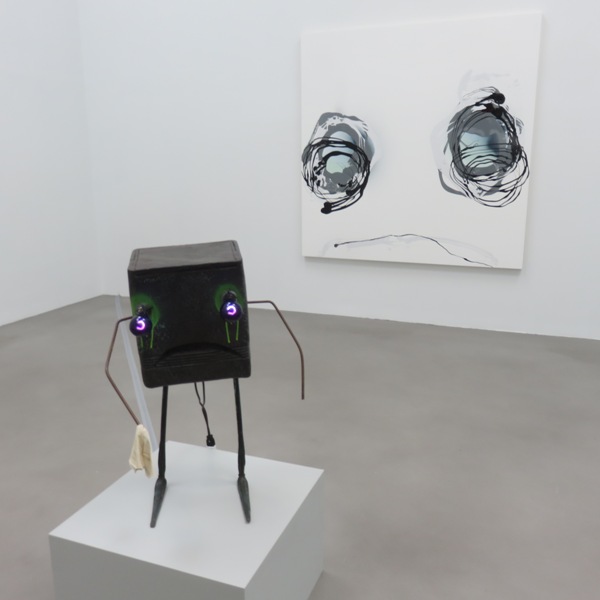
Installation view with works by Jon Pylypchuk.
Photo: Courtesy of Petzel Gallery.
10. Jorge Pardo, Jon Pylypchuk, Dirk Skreber at Petzel, through August 7.
It might seem unlikely that works by artists as diverse as Mexico’s Jorge Pardo, Los Angeles’s Jon Pylypchuk, and Germany’s Dirk Skreber would hang together well in a three-person show, but this turned out to be one of the best exhibitions of New York’s summer season.
Pardo is well known for his unique merger of art and design in utilitarian sculptural objects. Here, he uses 3-D printing technology to make life-size casts of studio assistants to create elaborate hanging light fixtures. A group of these displayed in a darkened room is a haunting and powerful installation.
Echoing the eerie mood created by Pardo’s work is Skreber’s slow-motion film of a car crash projected on a large screen in a rear gallery and accompanied by amplified sounds of the artist’s heart beating, among other ambient noises.
Adding some sarcastic pathos to the mix, Canadian-born LA-based Pylypchuk shows a new bronze sculpture of a boxy machine-like form, whose anthropological attributes include purple light bulbs for eyes, a pair of spindly legs, and arms holding a handkerchief—apparently this forlorn robot is in tears.
A group of four large, refined new paintings by Pylypchuk are missing the hand-scrawled texts characteristic of the artist’s earlier works. Each painting seems wholly abstract until one discerns the faintly described eyes and mouth; it’s an anonymous personage with a rather ambiguous expression.
David Ebony is a contributing editor of Art in America and a longtime contributor to artnet.